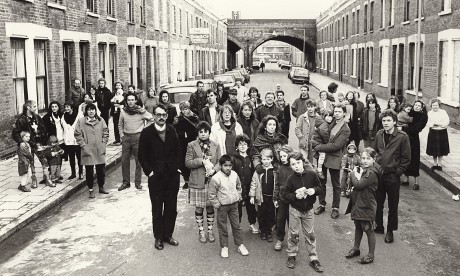
It’s hard to imagine now just how different a landscape the decaying industrial wasteland of London’s East End presented in the early 1970s through the murky veil of economic recession.
Here, among dormant factories, rotting riverside warehouses and boarded-up houses, a group of art school grads led by Jonathan Harvey and David Panton found their future.
“When we approached the Greater London Council for property they said you can squat, because there was a huge amount of squatting going on then, in which case we’ll get you out, or go away and form yourself into a housing association that will give you the legal structure to have a conversation with us,” Harvey recalls at his top-floor office in Mile End.
So in November 1972 seven founder members scraped together £10 apiece to form the artist-led charitable Acme Housing Association Ltd.
The GLC initially transferred two derelict shops on Devons Road in Bow. By December 1974, Acme was managing 76 houses, providing living and studio space for 90 artists and had established a relationship with the Arts Council to provide funding for the conversion of the artists’ studios.
“It’s quite extraordinary, we never planned to do it, it was always about self-help but then given the opportunity that these houses presented we thought well we must make them available to other artists,” Harvey says, evidently still somewhat surprised.
After four pioneering decades, Acme is now the subject of a special show at the Whitechapel Gallery exploring its radical history through archive material including posters, catalogues, photographs and films.
Radical experiment
Part of what makes the Acme story so compelling is the five-and-a-half years the group spent from 1976-81 turning a derelict banana warehouse in Covent Garden into a cutting-edge exhibition space for an incredible array of (literally) ground-breaking performance and installation artists.
“Being a short-life property that was due to for demolition, there was an attitude to the building that saw the space as sacrificial, so we quickly established a reputation for being uncompromising in terms of accommodating how an artist needed to present their work – even if it the space was being structurally challenged,” Harvey says.
One of those artists was Kerry Trengove, who in 1977 famously sealed himself into a bunker inside the gallery, tunnelling his way down through the basement only to emerge from a pile of rubble and dust on Shelton Street eight days later.
Then there was pyrotechnic sculptor Stephen Cripps who performed several times at the gallery, filling the space with a volatile mix of fire and explosives.
When it closed in 1981, critics mourned the loss of such an experimental, rebellious fixture on the gallery circuit, with Waldemar Januszczak declaring the 1970s “officially over.”
Despite his obvious affection for those experimental, unselfconscious years full of energy and zeal, Harvey maintains it was right for the gallery to close when it did.
“We’re talking about a period when that kind of 60s notion that an alternative to both commercial and public galleries could exist,” he says.
“Now it’s very difficult to be a public museum or a public gallery without being part of the market. I think the market is actually totally dominant now, so there’s a big question about where the alternative is or indeed where the radical is.”
Supporting artists
Acme recognised long ago that its future depended on property ownership and, with aid of capital lottery funding from the Arts Council and planning partnerships with house builders, it has managed to secure a substantial property portfolio unlike any other studio organisation in the country.
It’s a phenomenal though quiet success story of an organisation that Turner Prize-winning sculptor Rachel Whiteread, herself a former Acme studio holder (like roughly a third of all Turner Prize nominees, including eight winners), has called “silently one of the supportive bodies in operation.”
It may have taken 40 years but by April 2015 Acme will be entirely independent and self-sustaining, slowly generating increasing amounts of income to invest back into the arts at a time when local authorities are highly unlikely to be able, or indeed willing, to ring-fence funding to subsidise affordable studio space.
“Unfortunately I think there’s going to be a huge amount of loss of affordable studio space in the Eats End over the next few years. The rise in property prices in Hackney is absolutely extraordinary and how any artist can afford to live or work there in the future is really questionable,” Harvey says.
“Our buildings are not going to be regenerated out.”
Supporting Artists: Acme’s First Decade 1972-1982 runs at the Whitechapel Gallery until 23 February 2014
